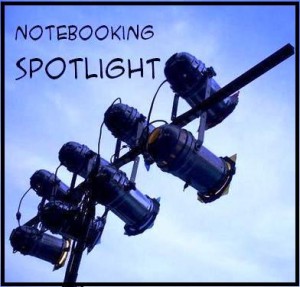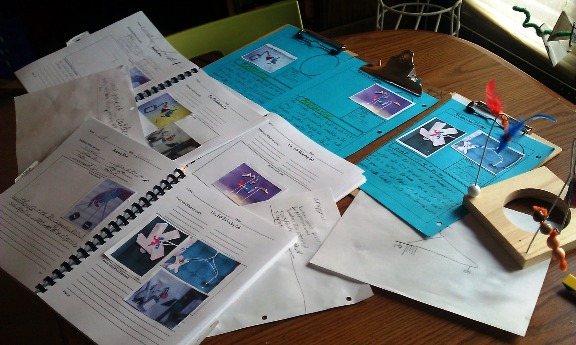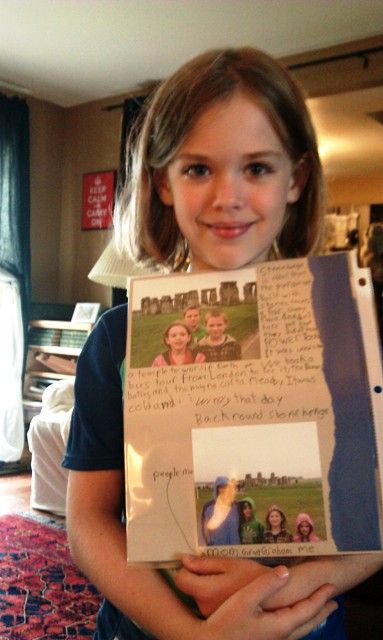- in Inspiration , Spotlight by Jimmie Quick
Notebooking Spotlight: Dee

(photo credit by Carmela Nava)
Today we have Dee in the spotlight.
Dee blogs about homeschooling her three children at Expeditions With Three G’s.
Dee, when did you start notebooking? How did you first learn of notebooking?
This is our fifth year of home education. During our first four years, we filled a four-inch notebook as we studied one complete cycle of history. I use The Story of the World activity guide pages as a form of notebooking. We are now revisiting the ancients.
I learned about notebooking through Ambleside and Simply Charlotte Mason.

What subjects do you use notebooking for?
Besides history, we use notebooking for science, geography, bible and art. (We tried to use notebooking for math and spelling, but it didn’t fit well for us.)
We used the Shedd Aquarium website to guide us through the animals. All three of my kids drew or described the animals in a composition notebook and then visited those animals on several field trips. We used notebook pages made by Jessica for Apologia’s Flying Creatures book when we got to the end of the list at the Shedd. She provided brilliant help for me even though my kids were not all crafty. I was able to use her comprehension questions to draw out answers from my kids to build notebook pages. We also used notebooking for Apologia’s astronomy book and Elemental Science‘s chemistry and physics.
For our human geography study, I turned the flag pages from Homeschooling with Index Cards into notebook pages. As my children study each continent’s from DK Geography of the World, they record what they learned in their notebooks.
Art notebooking worked well as we learning about artists and did projects for two levels of Artistic Pursuits.
Bible curriculum is kept in notebooks developed by Community Bible Study. These are somewhat worksheet-ish, but do often include written narrations.

What makes your notebooks unique?
Our notebooks are unique because each kid is different and wants to emphasize various details. And the notebooks include pictures of the children from our many field trips.
For example, each of my children has a picture taken
- in the Pantheon in Rome
- at the Aya Sophia in Istanbul
- at Stonehenge in England
What is your greatest obstacle in notebooking?
Using the right narration starter is my greatest obstacle for notebooking. Sometimes my children are ready to narrate, and sometimes they are not. When they are ready, the narration flows.
Choosing the right narration prompt for each child for each lesson seems to be key. I like using Jimmie’s narration starters.
Recently, while trying to get my oldest to narrate from a Roman mystery, I simply asked my son to look at Jimmie’s narration starter list and pick one that he could use. It worked!
Another helpful technique when a child can’t get the words or ideas out is to ask him to explain their lesson to Daddy. I ask, “How would you tell Daddy about it? Write that down.”
Dee, what notebooking tips can you share with us?
Print out pictures from your learning experiences and record a one sentence narration about the picture even if Mom has to write it out or the kids have to use a voice recorder and painstakingly type or print out each part of the story. They own the narration, and it becomes valuable to them.
 My son has decided that to narrate out loud while I type is much preferred over his recording it into a voice recorder and then writing it out on his own. Obviously, he’ll need to write or type on his own before the end of fifth grade, but I’m thrilled that he does pick out parts of each story to narrate.
My son has decided that to narrate out loud while I type is much preferred over his recording it into a voice recorder and then writing it out on his own. Obviously, he’ll need to write or type on his own before the end of fifth grade, but I’m thrilled that he does pick out parts of each story to narrate.
The one narration starter that he fondest of is, “Why did a character act as he did?” That answer usually develops into 2 separate paragraphs describing back ground information and the character’s actions.
Another tip is to persevere. It takes time to learn to narrate and to write down your kids’ narrations. But, if done in the beginning, narration becomes the foundation for further learning.
What kind of notebooking pages do you use? Freebies, retail, homemade?
Because I have 3 children born within 16 months of each other, I rarely have the forethought or preparation time necessary to make anything on my own. So I use notebooking pages developed by others: Elemental Science, Notebooking2learn, Homeschooling with Index Cards, Hands of a Child, Westvon History Scribe.
Dee, in your opinion, what are the educational advantages of notebooking?
The children own the notebooks and thus begin to care about building each page. The addition of scrapbooking gives them the opportunity to include pictures and narration about what science or art project they did as well or what field trip we took.
Textbooks and worksheets were all I was trained to use. I’ve come to learn that textbooks and worksheets are ineffective. Notebooking is different. Its teaches children to organize their thoughts and record them.
Further, notebooks are one of the best examples to doubting loved ones who aren’t sure we are doing our best for our children.
Thank you, Dee, for this detailed glimpse into notebooking at your home.
If you would like to be featured, please send me an email.
